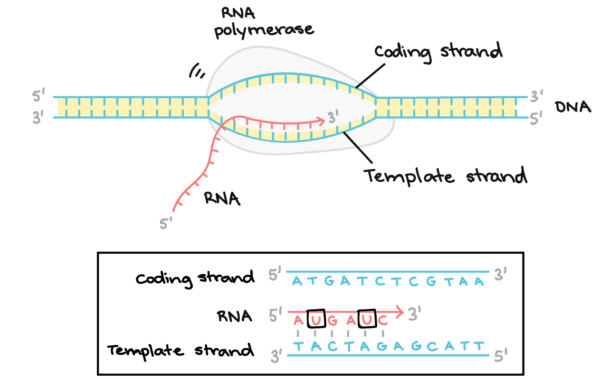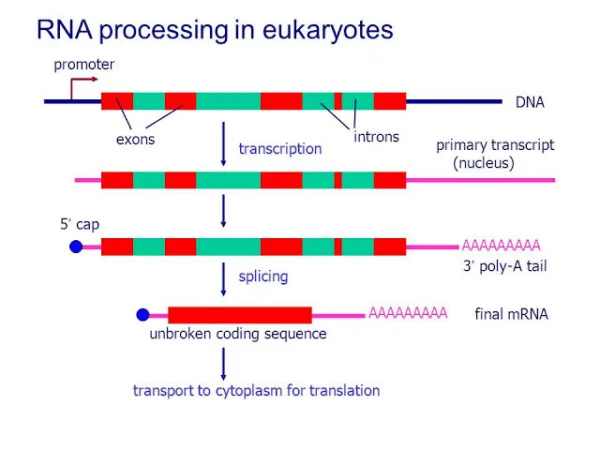Transcription, in genomics, involves creating an RNA copy of a gene’s DNA sequence. This RNA copy, known as messenger RNA (mRNA), carries encoded genetic information for protein synthesis. It plays a vital role in gene expression, converting gene information into functional products, like proteins.
mRNA Movement and Processing in Complex Organisms
In complex organisms like humans, mRNA moves from the cell nucleus to the cytoplasm, where it participates in protein synthesis. Eukaryotic transcripts undergo several processing steps before being translated into proteins. Transcription is an early stage in the sequential flow of genetic information from DNA to protein, occurring alongside translation. During transcription, only one strand of DNA, the template strand, is copied to produce mRNA.

Objective of Transcription: Producing RNA from DNA
The primary goal of transcription is to generate RNA from a DNA sequence. The RNA transcript, mRNA, contains the necessary information for protein encoding. It carries DNA information from the nucleus to the cytoplasm, where protein synthesis takes place. It involves copying DNA information into a newly formed mRNA molecule. While DNA acts as a stable genetic repository, mRNA is comparable to a reference book copy. Although mRNA carries the same information as DNA, it functions differently, not serving as long-term storage and freely exiting the nucleus. The mRNA sequence is complementary to the DNA template but not an exact replica.
Transcription Facilitation: RNA Polymerase and Transcription Factors
Transcription is facilitated by RNA polymerase, an enzyme, and transcription factors, accessory proteins. Transcription factors bind to specific DNA sequences called enhancer and promoter sequences, recruiting RNA polymerase to suitable sites. Together, transcription factors and RNA polymerase form the transcription initiation complex, initiating mRNA synthesis by matching complementary bases to the DNA strand. mRNA elongates until the full strand is synthesized, and transcription concludes. The newly formed mRNA copies serve as templates for protein synthesis during translation.
DNA transcription involves rewriting genetic information within DNA into mRNA using RNA polymerase. The resulting mRNA molecule exits the nucleus and serves as the foundation for DNA translation. By regulating mRNA production within the nucleus, the cell maintains control over gene expression rates.
RNA polymerase
RNA polymerase is an essential enzyme engaged in the transcription process, which involves creating RNA from a DNA template. It plays a critical part in gene expression by catalyzing the production of an RNA molecule that matches a DNA strand. RNA polymerase identifies distinct promoter sequences on the DNA molecule and triggers transcription by unwinding the DNA double helix. It then proceeds to elongate the recently synthesized RNA strand by adding ribonucleotides following the rules of complementary base pairing in a 5′ to 3′ direction. This enzyme ensures the accurate and efficient synthesis of RNA, facilitating the proper transfer of genetic information for protein synthesis. RNA polymerase is present in all living organisms and is classified into various types like RNA polymerase I, II, and III, each responsible for transcribing specific gene types. Gaining an understanding of RNA polymerase’s function and regulation is pivotal in unraveling the complexities of gene expression and comprehending its impact on cellular processes.
Stages of Transcription
The process of transcription involves several steps, which can be divided into initiation, elongation, termination, and RNA processing. Let’s explore each step in detail:

1. Initiation:
During initiation, the enzyme RNA polymerase binds to the DNA molecule and moves along the DNA strand until it recognizes a promoter sequence. Promoter sequences indicate the starting point of transcription and can be found in multiple locations within a DNA molecule. Transcription factors, proteins that control the rate of process, also bind to the promoter sequences along with RNA polymerase. Once bound to the promoter sequence, RNA polymerase unwinds a portion of the DNA double helix, exposing the bases on each of the two DNA strands.
2. Elongation:
In the elongation phase, RNA polymerase uses ribonucleotides to form a new mRNA strand. The template strand of DNA, read in a 3′ to 5′ direction, provides the template for the mRNA molecule. The other DNA strand, known as the coding strand, has a base sequence identical to the synthesized mRNA, except for the replacement of thymine (T) bases with uracil (U). RNA polymerase catalyzes the formation of phosphodiester bonds between adjacent ribonucleotides, using complementary base pairing (A to U, T to A, C to G, and G to C). The mRNA strand elongates in a 5′ to 3′ direction since bases can only be added to the 3′ end.
3. Termination:
Elongation continues until the RNA polymerase encounters a stop sequence, also called a terminator sequence. At this point, transcription stops, and the RNA polymerase releases the DNA template. Termination marks the end of transcriptions process.
4. RNA Processing:
After transcription, the transcribed RNA is known as pre-mRNA. It undergoes several processing steps to convert it into mature mRNA, which is ready for translation. The RNA processing steps include:
5′ Capping:
A methylated guanine cap is added to the 5′ end of the mRNA. This cap is essential for the recognition of the mRNA by ribosomes and protects it from degradation by RNAases.
Polyadenylation:
A poly(A) tail, consisting of multiple adenosine monophosphates, is added to the 3′ end of the mRNA. This poly(A) tail helps stabilize the mRNA, as RNA is generally more unstable than DNA.
Splicing:
Splicing is the process of removing non-coding sequences called introns from the pre-mRNA and joining together the coding sequences called exons. This allows a single pre-mRNA to code for multiple proteins, conserving genetic material. Splicing is facilitated by a complex called the spliceosome. The removal of introns and ligation of exons generate a mature mRNA that serves as the messenger for translation and protein synthesis.
During transcription, the mRNA is transcribed in the nucleus in eukaryotes and in the cytoplasm in prokaryotes. The mature mRNA contains an open reading frame (ORF) that is translated into protein, while the untranslated regions (UTRs) at the 5′ and 3′ ends are not translated during protein synthesis.

Important Questions and Answers
Q: What is DNA transcription and how does it work?
A: DNA transcription is the process where RNA is synthesized from a DNA template. The enzyme RNA polymerase recognizes specific promoter sequences on the DNA molecule and initiates the unwinding of the DNA double helix. Ribonucleotides are added by RNA polymerase to elongate the newly formed RNA strand, following complementary base pairing rules. This process creates an RNA molecule that complements the DNA template.
Q: Why is DNA transcription important?
A: DNA transcription is crucial because it enables gene expression. By transcribing DNA into RNA, it facilitates the transfer of genetic information necessary for protein production. This process allows cells to regulate gene expression and perform various biological functions.
Q: Who are the key players in DNA transcription?
A: RNA polymerase, the enzyme responsible for synthesizing RNA from a DNA template, is a key player in DNA transcription. Promoter sequences on the DNA molecule serve as recognition sites for RNA polymerase to initiate the process. Transcription factors, proteins that assist in regulating RNA polymerase activity and transcription initiation, are also involved.
Q: How is DNA transcription regulated?
A: DNA transcription is regulated through various mechanisms. Transcription factors bind to specific DNA sequences, enhancing or inhibiting RNA polymerase activity. Epigenetic modifications like DNA methylation or histone acetylation can affect the transcripting process by altering DNA accessibility. Regulatory elements such as enhancers and silencers interact with specific DNA regions to control transcription.
Q: What are the different types of RNA produced during transcription?
A: During transcription, several types of RNA are produced. Messenger RNA (mRNA) carries the genetic code from DNA to ribosomes for protein synthesis. Transfer RNA (tRNA) assists in protein synthesis by delivering amino acids to ribosomes. Ribosomal RNA (rRNA) is a component of ribosomes involved in protein synthesis. Non-coding RNAs also have regulatory functions in gene expression and cellular processes.
References:
- Alberts, B., Johnson, A., Lewis, J., Raff, M., Roberts, K., & Walter, P. (2014). Molecular biology of the cell (6th ed.). Garland Science. Chapter 7, DNA: Transcription, Processing of Eukaryotic RNA.
- Lodish, H., Berk, A., Zipursky, S. L., Matsudaira, P., Baltimore, D., & Darnell, J. (2000). Molecular cell biology (4th ed.). W. H. Freeman. Section 8.2, Transcription in Eukaryotes.
- Griffiths, A. J. F., Miller, J. H., Suzuki, D. T., Lewontin, R. C., & Gelbart, W. M. (2000). An Introduction to Genetic Analysis (7th ed.). W. H. Freeman. Chapter 9, How Genes Work.
- Taiz, L., & Zeiger, E. (2010). Plant Physiology (5th ed.). Sinauer Associates. Chapter 12, Regulation of Gene Expression.
- Berg, J. M., Tymoczko, J. L., & Gatto, G. J. (2012). Stryer’s Biochemistry (7th ed.). W. H. Freeman. Chapter 28, DNA Replication, Repair, and Recombination.
- Nelson, D. L., Cox, M. M. (2017). Lehninger Principles of Biochemistry (7th ed.). W. H. Freeman. Chapter 28, The Mechanism of Transcription in Eukaryotes.
- Lodish, H., Berk, A., Kaiser, C. A., Krieger, M., Scott, M. P., Bretscher, A., … & Matsudaira, P. (2008). Molecular Cell Biology (6th ed.). W. H. Freeman. Chapter 6, DNA Replication, Repair, and Recombination.
- Lewin, B. (2007). Genes IX. Jones and Bartlett Publishers. Chapter 11, Eukaryotic Transcription.
- Watson, J. D., Baker, T. A., Bell, S. P., Gann, A., Levine, M., & Losick, R. (2014). Molecular Biology of the Gene (7th ed.). Cold Spring Harbor Laboratory Press. Chapter 7, The Transcription Apparatus.
- Berg, J. M., Tymoczko, J. L., Gatto, G. J., & Stryer, L. (2019). Biochemistry (9th ed.). W. H. Freeman. Chapter 28, DNA Replication, Repair, and Recombination.